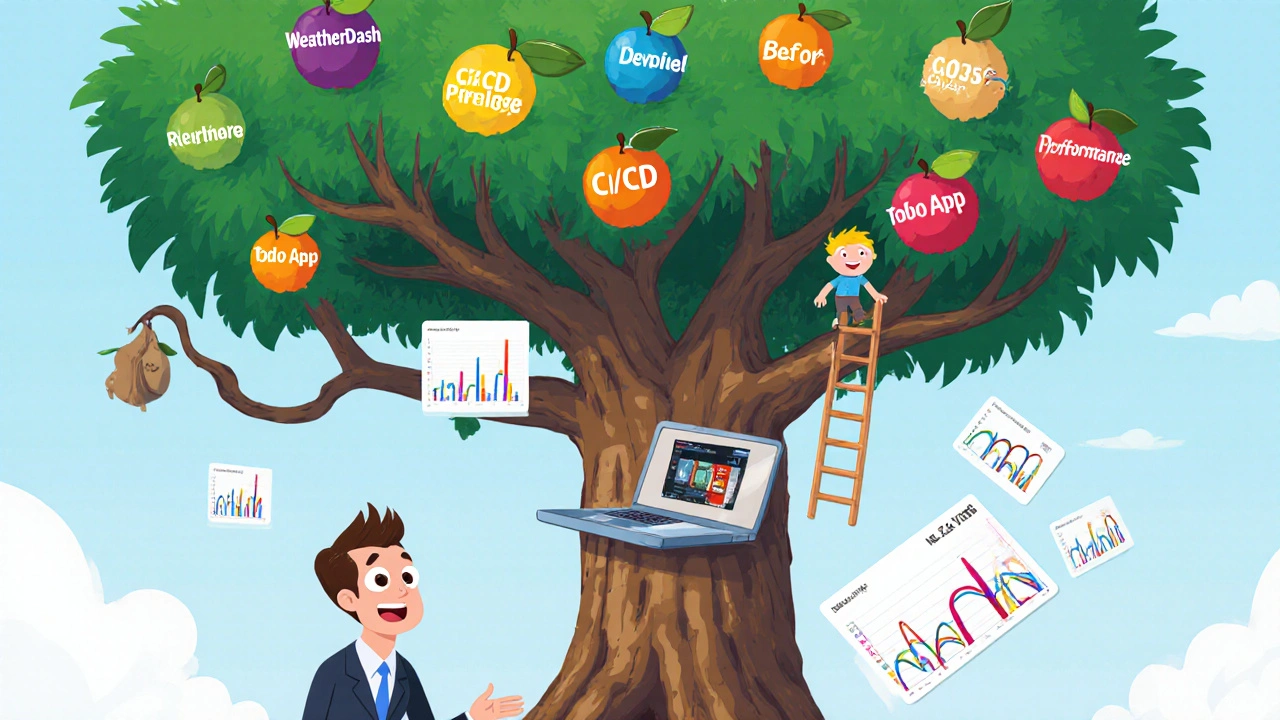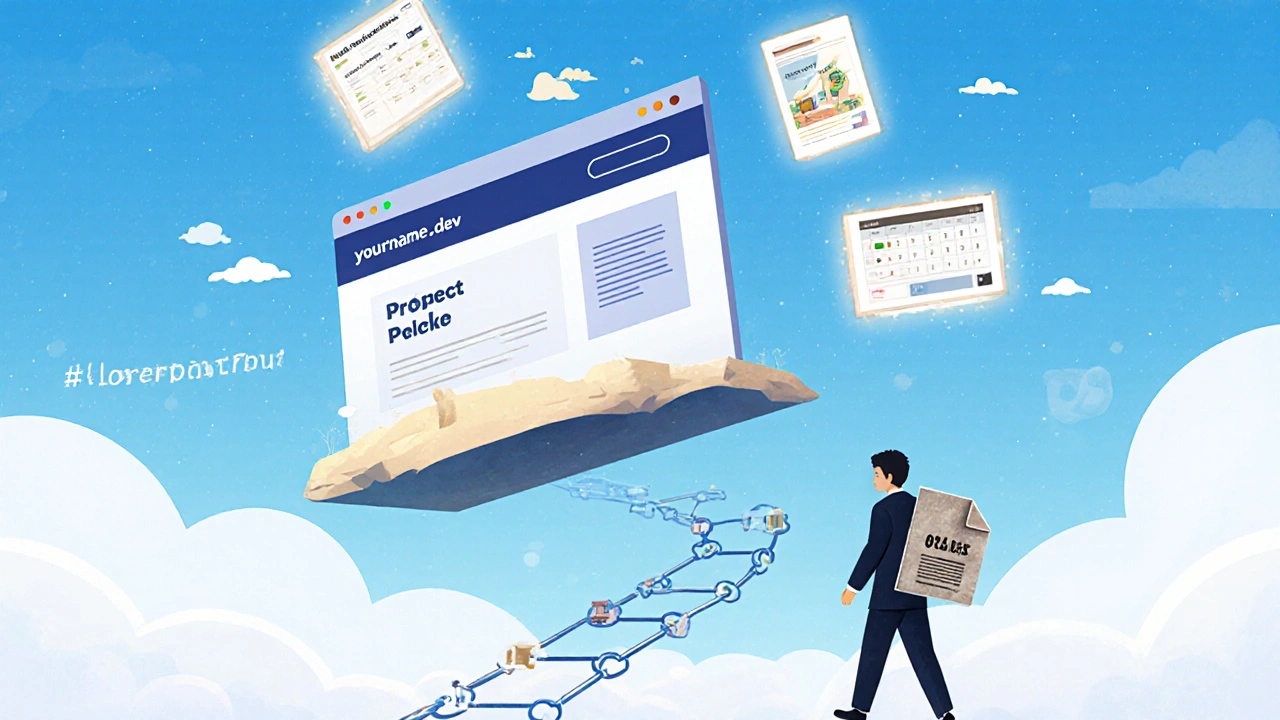Career Portfolios for Developers: GitHub, Readmes, and Demos That Actually Get Noticed
 Sep, 21 2025
Sep, 21 2025
Most developers spend hours writing clean code, fixing bugs, and learning new frameworks. But when it comes to landing a job, their GitHub profile looks like a graveyard of abandoned projects. No description. No screenshots. No explanation of why any of it matters. If your portfolio doesn’t tell a story, employers won’t bother reading your code.
Why Your GitHub Isn’t Enough
GitHub is the default resume for developers. But having a GitHub account isn’t the same as having a portfolio. Thousands of developers have public repos with no context. You might have built a React app that pulls real-time weather data. But without a clear README, no one knows what it does, why you built it, or what skills you used.Companies don’t hire code. They hire problem-solvers. Your portfolio needs to show how you think, not just what you typed.
A 2024 survey of 200 hiring managers in U.S. tech companies found that 78% skipped candidates whose GitHub profiles had no README files. Another 62% said they’d reject a candidate if their demo projects looked unfinished or lacked documentation. Your code is only half the story.
What Makes a Strong README
A great README isn’t a technical spec. It’s a sales pitch written for humans.Start with a clear headline: “WeatherDash: Real-time forecast app built with React and OpenWeather API”. Then answer these four questions in order:
- What’s the problem? “People forget to check the weather before leaving home and get caught in storms.”
- What did you build? “A mobile-first dashboard that shows hourly forecasts, UV index, and rain probability with one tap.”
- How did you build it? “React for the UI, Tailwind CSS for styling, OpenWeather API for data, and GitHub Actions to auto-deploy to Netlify.”
- What did you learn? “I learned how to handle API rate limits and how to design for low-connectivity users.”
Include a screenshot or short video. Even a 15-second Loom clip showing the app in action beats a static image. Use emojis sparingly-just enough to break up text. No one wants to read a README that looks like a Twitter thread.
Pro tip: Add a “Contributing” section. Even if your project is personal, showing you understand collaboration signals you can work on a team. Write one line: “Pull requests welcome for UI improvements or bug fixes.”
Build Demos That Show Real Skills
Don’t build another todo app. Everyone has one. Instead, build something that mirrors real work.Here are three project ideas that stand out:
- Automated deployment pipeline - Show you can set up CI/CD with GitHub Actions. Deploy a simple web app that auto-updates when you push code. Document the steps. Include the build time and success rate.
- API integration with error handling - Build a tool that pulls data from three different APIs (e.g., Google Maps, Stripe, and Twitter). Show how you handle rate limits, timeouts, and failed responses. This proves you don’t just write code-you handle real-world messiness.
- Performance optimization case study - Take an existing open-source project. Profile its load time. Make it 40% faster. Document what you changed: lazy loading, image compression, code splitting. Then compare before-and-after metrics.
These aren’t just projects. They’re proof you can ship real software under real constraints.

Link Everything Together
Your portfolio isn’t just your GitHub. It’s your GitHub, your READMEs, your live demos, and your LinkedIn-all connected.On your GitHub profile bio, add a link to your personal website or portfolio page. Even a simple Notion page works. Put your best three projects there, with screenshots, short videos, and a one-line summary of what you learned.
On LinkedIn, post a thread: “Here’s how I built a weather app in 48 hours-and what I learned about API reliability.” Tag it with #developerportfolio #codingportfolio. People who scroll past your resume might stop for a story.
Use a single domain for all your links: yourname.dev. It’s cheap ($10/year), looks professional, and gives you full control. Host your demo projects there. Link to your GitHub. Add a short bio. Done.
What to Avoid
Avoid these common mistakes:- Repos with no commits in 2 years - If you haven’t touched a project in a year, archive it. Don’t let it clutter your profile.
- Code without comments - If your code looks like a cryptic poem, you’re making hiring managers work too hard.
- Only showing frontend work - If you’ve never touched a database, API, or deployment tool, say so. Or better yet, build one.
- Using placeholder text - Replace “Lorem ipsum” with real content. “This app helps users track their daily water intake” sounds way better than “Enter your name here.”
Also, don’t copy other people’s portfolios. Don’t use the same color scheme as the “Top 10 Developer Portfolios” article you saw on Dev.to. Your portfolio should sound like you, not a template.

Update It Like a Living Document
Your portfolio isn’t a one-time task. Treat it like a blog. Every time you learn something new-whether it’s Docker, TypeScript, or how to write a good commit message-add it.Update your READMEs. Add a new project. Push a fix to an old repo. Even a small update signals you’re active. Hiring managers notice consistency.
Set a reminder every 60 days to review your portfolio. Ask yourself: “If I were hiring a developer, would I invite this person for an interview?” If the answer is no, change it.
How Employers Actually Use Portfolios
Most interviews start with a portfolio review. Not the resume. Not the coding test. The portfolio.Here’s what happens in a real 15-minute portfolio review:
- The interviewer opens your GitHub. Looks at your most recent commit. (If it’s from 2023, they sigh.)
- They click your best project. Reads the README. If it’s clear and honest, they keep reading.
- They open the live demo. Click around. Try to break it.
- They ask: “What was the hardest part?” “What would you do differently now?”
- If you answer honestly and show growth, you’re in the next round.
It’s not about how many stars your repo has. It’s about how clearly you explain your work.
Start Today-Even If It’s Tiny
You don’t need a perfect portfolio. You need a started one.Take one project you already built. Add a README. Write four sentences answering the four questions above. Take a screenshot. Deploy it to Netlify for free. Link it on your LinkedIn.
That’s it. You’ve just built a portfolio that’s better than 80% of developers out there.
Don’t wait until you know everything. Show what you know now-and how you learn.
Do I need a personal website for my developer portfolio?
No, but it helps. You can get by with just GitHub and LinkedIn if your READMEs are strong and your demos are live. But a simple personal site-like yourname.dev-gives you control over how you present yourself. It’s a professional anchor point. Use free tools like Vercel, Netlify, or GitHub Pages to host it. No need for fancy design. Just clear links, a short bio, and your top three projects.
How many projects should I include in my portfolio?
Three to five is ideal. Quality beats quantity. One well-documented, fully deployed project with a clear README and live demo is worth ten half-finished apps. Pick projects that show different skills: frontend, backend, APIs, deployment, testing. If you only have one strong project, make it amazing. Don’t pad your profile with filler.
Should I include school projects in my portfolio?
Only if they’re good. A basic class assignment with no documentation or deployment won’t help. But if you took a class project and improved it-added tests, wrote a README, deployed it, or added features-that counts. Employers care more about what you did after the assignment than what was required. Show initiative.
What if I don’t have any real-world experience?
Build fake problems that feel real. Create a tool that helps local coffee shops track inventory. Build a budget tracker for students. Make a site that shows bus schedules for your city. These aren’t “fake”-they’re solutions to real needs. Document the process. Show how you researched the problem. That’s real experience. Employers care more about your problem-solving than your job title.
How often should I update my portfolio?
Every 60 days. Even small updates matter. Push a new commit. Add a screenshot to an old README. Deploy a fix. Write a short post about what you learned. Consistency signals that you’re active and growing. Waiting until you’re “ready” means you’ll never start. Show up, even if you’re not perfect.
Anand Pandit
October 31, 2025 AT 11:53Just updated my README last night after reading this. Added a screenshot, a 12-second Loom clip, and wrote the four-question structure you mentioned. Took me 20 minutes. My GitHub actually looks human now. Thanks for the nudge.
Reshma Jose
November 1, 2025 AT 02:21I deleted three old repos today. One was a college project from 2021 with ‘Lorem ipsum’ everywhere. Honestly? I felt lighter. This post is the kick I needed.
rahul shrimali
November 2, 2025 AT 15:26Build something real not just another todo app
Bhagyashri Zokarkar
November 3, 2025 AT 14:53you know what i hate the most like seriously why do people think github is enough like i mean come on its just code no context no story no soul like i opened one guy's profile and there were 47 repos all named 'project1' 'project2' 'final' and one called 'i tried but gave up' and i just sat there like what even is this life
Vishal Gaur
November 5, 2025 AT 13:06i read this whole thing and then went to check my own github and honestly i cried a little. i have this one project i built for a hackathon two years ago. i never deployed it. never wrote a readme. just pushed it and forgot. now i feel like a fraud. but i'm gonna fix it. tonight. i swear.
Sheetal Srivastava
November 6, 2025 AT 11:41Let’s be honest-most devs treat their GitHub like a digital hoarder’s attic. You don’t need another React todo app. You need a curated, intentional artifact of your cognitive architecture. The README is your epistemological manifesto. Without it, your code is merely syntactic noise. And if you’re not using GitHub Actions for CI/CD, you’re not even in the game. You’re just a hobbyist with a git clone.
Also, if your demo isn’t hosted on Vercel with a custom domain and a Web Vitals dashboard, you’re not serious. And please, for the love of all that is holy, stop using placeholder text. ‘Enter your name here’ is not a UI. It’s an insult to the user’s intelligence.
And don’t even get me started on people who list ‘JavaScript’ as a skill and then have zero Node.js exposure. That’s not a full-stack dev. That’s a frontend copy-paster with imposter syndrome and a LinkedIn premium subscription.
Your portfolio isn’t a resume. It’s a behavioral fingerprint. It tells me how you think under constraint. How you debug. How you communicate. How you fail. And if you’re not documenting your failures? You’re not learning. You’re just accumulating commits.
Also, why are people still using Bootstrap? We’re in 2024. Tailwind is the new baseline. If you’re not using CSS-in-JS or atomic CSS, you’re writing legacy code. And if your project doesn’t have a CONTRIBUTING.md? You’re not ready for team environments. You’re a lone wolf. And the industry doesn’t want lone wolves anymore. We want collaborators. With documentation.
And don’t even get me started on the ‘I don’t need a personal site’ crowd. Your LinkedIn profile is a corporate brochure. Your GitHub is a raw dump. Your personal site? That’s your brand. Your identity. Your digital soul. If you can’t afford a $10 domain, you’re not serious about your craft. Period.
And if you’re still using Jekyll for your site? You’re not a developer. You’re a time traveler from 2016.
Bharat Patel
November 6, 2025 AT 15:02It’s funny how we think coding is the hard part. But the real skill? Explaining what you did. That’s the art. The code just follows the thought.
Bhavishya Kumar
November 7, 2025 AT 08:28There is a grammatical error in the third paragraph of the 'What Makes a Strong README' section. The sentence 'GitHub is the default resume for developers. But having a GitHub account isn’t the same as having a portfolio.' is correctly punctuated, but the subsequent sentence begins with a lowercase 'you' after a period, which is incorrect. Furthermore, the phrase 'no one wants to read a README that looks like a Twitter thread' should be preceded by a semicolon, not a period, as it is a continuation of the prior thought. Such errors undermine credibility in technical communication.
Eka Prabha
November 8, 2025 AT 00:35Let me guess-this article was written by someone who got hired because they had a ‘cool’ portfolio and now they’re selling the myth that anyone can do it. Meanwhile, I’ve got 7 years of experience, shipped enterprise apps, and my GitHub is clean because I don’t waste time on fake projects. I use internal tools. No one outside my company sees them. And guess what? I still got promoted. Your ‘portfolio’ is just a distraction for juniors who don’t know how the real world works. Companies hire experience, not GitHub aesthetics.
Also, why do you assume everyone has time to build ‘demos’? I work 60-hour weeks. I don’t have time to make Loom videos. This is classist. You’re telling people with real responsibilities to perform for you.
Nikhil Gavhane
November 9, 2025 AT 10:58I used to think my portfolio needed to be perfect. Then I realized-people don’t care about perfection. They care about honesty. I added one project last week. Just a simple API wrapper. No fancy design. Just a README that said: ‘I didn’t know how to handle errors at first. This is what I learned.’ That’s all it took. Someone reached out to ask if I’d help with their project. I didn’t even ask for it.
Rajat Patil
November 9, 2025 AT 12:36I appreciate the thoughtful guidance presented in this article. It is both practical and grounded in observed industry trends. The emphasis on clarity, consistency, and communication over mere technical output is a vital reminder for aspiring developers. The suggestion to treat one’s portfolio as a living document is particularly insightful, as it reflects the iterative nature of professional growth. Thank you for this well-structured and humane perspective.
Raji viji
November 9, 2025 AT 12:54Bro this is the most cringe advice I’ve ever read. You think a README with emojis and a Loom video is gonna get you hired? Nah. Real devs don’t care about your ‘story’. They care if your code passes the FizzBuzz test and doesn’t crash the server. Your ‘portfolio’ is just a TikTok for coders. I’ve seen 100 of these ‘I built a weather app’ guys. Half of them can’t explain what a REST endpoint is. Stop performing. Start coding. And if you’re not building at scale with real users? You’re just playing pretend.
Also-Netlify? Really? That’s for hobbyists. If you’re not deploying on AWS with Terraform and monitoring with Datadog, you’re not ready for production. Stop wasting time on GitHub Pages. You’re not a frontend designer. You’re a developer. Act like it.
pk Pk
November 10, 2025 AT 17:11Hey new devs-don’t get discouraged by the haters. This post is gold. I mentored 3 people last month using exactly this approach. One got a job at a startup just because their README said, ‘I broke the API three times before I figured out rate limits.’ That’s real. That’s human. That’s what hiring managers remember. Keep going. You don’t need to be perfect. Just be honest.
Rubina Jadhav
November 11, 2025 AT 14:30I never thought about adding a contributing section. That’s actually so simple but so smart. I’m doing it tonight.
Rakesh Dorwal
November 13, 2025 AT 14:24Why do Western tech blogs always assume everyone has internet access to deploy projects? In India, data is expensive. Netlify? Vercel? I pay ₹50 per 1GB. I can’t just ‘deploy for free’ every time I make a change. This advice is for privileged kids with unlimited bandwidth. Real developers work offline. Build for low connectivity. That’s real skill.
sumraa hussain
November 14, 2025 AT 20:33bro i just looked at my github and i have 23 repos and like 18 of them are just screenshots of error messages i took while crying at 3am... i think i need to archive them all... but also... maybe i should make one of them into a real portfolio? like... what if i turned my pain into a project? like ‘how not to debug node.js at 3am’ with all my failed attempts and what finally worked? would that be weird? or would that be real?
Shivani Vaidya
November 16, 2025 AT 00:43One of the most overlooked aspects: commit messages. I’ve seen candidates with beautiful READMEs but commit messages like ‘fixed stuff’ or ‘update’. That tells me more than the code. If you can’t communicate in small steps, you won’t communicate in large ones. Clean commits are silent interviews.
deepak srinivasa
November 17, 2025 AT 01:08What if your best project is something you built with a friend but you don’t own the repo? Do you fork it? Do you recreate it? Or do you just link to it and explain your role? I’m stuck here.
ujjwal fouzdar
November 18, 2025 AT 20:06We are not just writing code. We are writing stories. Every commit is a chapter. Every README, a manifesto. Every deployed app, a whisper into the void: ‘I was here. I tried. I learned.’ And if no one sees it? That’s not failure. That’s silence. But silence can be broken. With one line. One screenshot. One honest sentence. You don’t need to be the best. You just need to be real. And in a world full of polished lies? That’s the rarest thing of all.